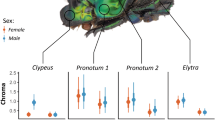Summary
This paper describes the influence on predator behaviour, and the survival of an aposematic aphid, Aphis nerii, in comparison with a palatable, cryptic aphid, Acyrthosiphon pisum, when offered to two predators with different foraging tactics. The experiments were designed to test Fisher's (1930) suggestion that aposematism could evolve by kin selection, since aposematic animals often occur in aggregations of relatives. Initially, spiders (Zygiella x-notata) and birds (Parus major) killed high proportions of distasteful A. nerii (60% and 54% respectively). With experience, the predators killed and ate fewer A. nerii. The decreasing mortality of A. nerii after initial encounters with predators, coupled with its apparently obligate parthenogenesis, indicate that the evolution of aposematism in this soft-bodied insect is consistent with kin selection.
Similar content being viewed by others
References
Barth FG (1982) Spiders and vibratory signals: sensory reception and behavioral significance. In: Witt PN, Rovner JS (eds) Spider communication: Mechanisms and ecological significance. Princeton University Press, Princeton, pp 67–122
Brower LP, Glazier SC (1975) Localization of heart poisons in the monarch butterfly. Science 188:19–25
Brown KS Jr (1984) Adult-obtained pyrrolizidine alkaloids defend ithomiine butterflies against a spider predator. Nature 309:707–709
Dawkins R (1971) A cheap method of recording behavioural events, for direct computer-access. Behaviour 40:162–173
Edmunds M (1974) Defence in animals: a survey of anti-predator defences. Longman, Harlow, pp 357
Eisner T, Grant RP (1981) Toxicity, odor aversion, and “olfactory aposematism”. Science 213:476
Fisher RA (1930) The genetical theory of natural selection. Clarendon Press, Oxford, pp 272
Gibb JA, Betts MM (1963) Food and food supply of nestling tits (Paridae) in Breckland pine. J Anim Ecol 32:489–533
Gittleman JL, Harvey PH (1980) Why aren't distasteful prey cryptic. Nature 286:149–150
Gittleman JL, Harvey PH, Greenwood PJ (1980) The evolution of conspicuous coloration: some experiments in bad taste. Arim Behav 28:897–899
Guilford T (1985) Is kin selection involved in the evolution of warning coloration? Oikos 45:31–36
Hall RW, Ehler LE (1980) Population ecology of Aphis nerii on oleander. Environ Entomol 9:338–344
Hamilton WD (1971) Geometry for the selfish herd. J Theor Biol 31:295–311
Harvey P (1983) Why some insects look pretty nasty. New Scientist 97:26–27
Harvey PH, Greenwood PJ (1978) Anti-predator defence strategies: some evolutionary problems. In: Krebs JR, Davies NB (eds) Behavioural Ecology. Blackwell, Oxford, pp 129–151
Harvey PH, Paxton RJ (1981) The evolution of aposematic coloration. Oikos 37:391–393
Harvey PH, Bull JJ, Pemberton M, Paxton RJ (1982) The evolution of aposematic coloration in distasteful prey: a family model. Am Nat 119:710–719
Janetos AC (1982) Foraging tactics of two guilds of web-spinning spiders. Behav Ecol Sociobiol 10:19–27
Järvi T, Sillén-Tullberg B, Wiklund C (1981) The cost of being aposematic. An experimental study of predation on larvae of Papilio machaon by the great tit Parus major. Oikos 36:267–272
Jeffords MR, Sternburg JD, Waldbauer GP (1979) Batesian mimicry: field demonstration of the survival value of pipevine swallowtail and monarch color patterns. Evolution 33:275–286
Kidd NAC (1982) Predator avoidance as a result of aggregation in the grey pine aphid, Schizolachnus pineti. J Anim Ecol 51:397–412
Klärner D, Barth R (1982) Vibratory signals and prey capture in orb-weaving spiders (Zygiella x-notata, Nephila clavipes; Araneidae). J Comp Physiol 148:445–455
Malcolm SB (1981) Defensive use of plant-derived cardenolides by Aphis nerii Boyer de Fonscolombe against predation. PhD dissertation, Oxford University, pp 165
Nyffeler M, Benz G (1981) Freilanduntersuchungen zur Nahrungsökologie der Spinnen: Beobachtungen aus der Region Zürich. Anz Schädlingskd Pflanz Umweltschutz 54:33–39
Olive CW (1982) Behavioral response of a sit-and-wait predator to spatial variation in foraging gain. Ecology 63:912–920
Poulton EB (1908) Essays on Evolution 1889–1907. Clarendon Press, Oxford, pp 479
Riechert SE, Luczak J (1982) Spider foraging: Behavioral responses to prey. In: Witt PN, Rovner JS (eds) Spider communication: mechanisms and ecological significance. Princeton University Press, Princeton, pp 353–385
Roeske CN, Seiber JN, Brower LB, Moffitt CM (1976) Milk-weed cardenolides and their comparative processing by monarch butterflies (Danaus plexippus L.). Rec Adv Phytochem 10:93–167
Rothschild M, von Euw J, Reichstein T (1970) Cardiac glycosides in the oleander aphid Aphis nerii. J Insect Physiol 16:1191–1195
Schoener TW (1971) Theory of feeding strategies. Annu Rev Ecol Syst 2:369–404
Schoener TW (1979) Inferring the properties of predation and other injury-producing agents from injury frequencies. Ecology 60:1110–1115
Schuler W, Hesse E (1985) On the function of warning coloration: a black and yellow pattern inhibits prey-attack by naive domestic chicks. Behav Ecol Sociobiol 16:249–255
Sillén-Tullberg B, Bryant EH (1983) The evolution of aposematic coloration in distasteful prey: an individual selection model. Evolution 37:993–1000
Sillén-Tullberg B, Wiklund C, Järvi T (1982) Aposematic coloration in adults and larvae of Lygaeus equestris and its bearing on müllerian mimicry: an experimental study on predation on living bugs by the great tit Parus major. Oikos 39:131–136
Treherne JE, Foster WA (1980) The effects of group size on predator avoidance in a marine insect. Anim Behav 28:1119–1123
Trimen R (1869) On some remarkable mimetic analogies among Avrican butterflies. Trans Linn Soc Zool 26:497–522
Vasconcellos-Neto J, Lewinsohn TM (1984) Discrimination and release of unpalatable butterflies by Nephila clavipes, a neotropical orb-weaving spider. Ecol Entomol 9:337–344
Vermeij GJ (1982) Unsuccessful predation and evolution. Am Nat 120:701–720
Wiklund C, Järvi T (1982) Survival of distasteful insects after being attacked by naive birds: a reappraisal of the theory of aposematic coloration evolving through individual selection. Evolution 36:998–1002
Author information
Authors and Affiliations
Rights and permissions
About this article
Cite this article
Malcolm, S.B. Aposematism in a soft-bodied insect: a case for kin selection. Behav Ecol Sociobiol 18, 387–393 (1986). https://doi.org/10.1007/BF00299669
Received:
Accepted:
Published:
Issue Date:
DOI: https://doi.org/10.1007/BF00299669




